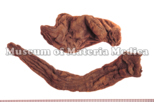Scrophularia Root

|
TMPW No.:32 |
| Synonym | |
| Latin name | Scrophulariae Radix |
| Botanical source: Family name | Scrophulariaceae |
| Botanical source: Plant name | - Scrophularia ningpoensis Hemsley (IPNI:809386-1) - Scrophularia buergeriana Miquel (IPNI:809070-1) |
| Part used | Root |
| Empirical criteria for quality selection | Good one is light brown externally and black internally. Enlarged and rich in moisture is preferable. (NI) |
| Constituents | Monoterpenoids: Iridoids: Harpagide Sterols: Phytosterol Phenylpropanoids: p-Methoxycinnamic acid |
| Pharmacological effects | Cardiotonic, vasodilation, decrease in blood pressure, decrease in blood sugar, local irritation, antifungal (extract), antifebrile (p-methoxycinnamic acid). |
| Indications | As an antifebrile, tranquilizer, antiinflammatory drug and removing sores, it is applied to treat febrile disease, sore throat, rhinitis, carbuncles, scrofula and constipation. |
| Diseases | High fever, Disturbance of consciousness, Swelling and pain of the throat, Red eye, Hot flash, Cough, Hemoptysis, Thromboangiitis obliterans, Cervical lymphadenopathy, Tuberculosis, Constipation |
| Formulas | kamiuntanto , shinsentaitsuko , seinetsuhokito , seinetsuhoketsuto |
| Meridian tropism | Lung, Stomach, Kidney |
| Property | Cold |
| Flavor | Bitter, salty |
| Classification in "Shen-non Ben-cao Jing" | Middle |
| TCM: Classification | Antipyretics |
| TCM: Medicinal effects | To reduce heat from blood, to nourish yin, to quench fire, and to counteract toxicity. For febrile disease with impairment of yin manifested by deep red tongue and dire thirst, or with eruptions, constipation due to impairment of body fluid, phthisis with cough, conjunctivitis, sore throat, scrofula, diphtheria, boils and sores. |
| Remarks | Listed in the Japanese standards for non-pharmacopoeial crude drugs 2018. |
| References | NI: N. Isshiki, Methods of Quality Evaluation and Preparation of Wakan-yaku, Tohodo Shoten, Tokyo, 1987. |
